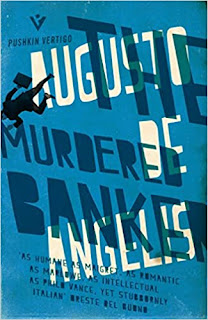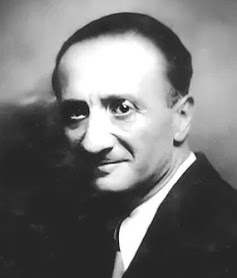The first Inspector De Vincenzi mystery by Augusto De Angelis
 |
| Augusto De Angelis's mystery The Murdered Banker is set in the Milan of the 1930s |
First
published in 1935 in Italian as Il banchiere assassinato, the novel
appeared at the peak of the British Golden Age of detective fiction, six years
after Italian publishers Mondadori had launched their crime series in yellow (giallo) covers that would later result in the word gialli being used to refer to
mystery novels and films.
There were
no Italian authors on the first Mondadori list as the publishers did
not see Italy as the right setting for the crime genre at that time.
However, journalist
De Angelis did not agree, as he thought crime fiction was a natural result and
product of the fraught and violent times he was living in and writing about.
To begin
with, Mussolini and his associates approved of the crime fiction genre because
it celebrated the achievements of the forces of order over evil and chaos by
bringing about just solutions and restoring tranquillity. However, they eventually
became wary of Italy being seen to be anything less than idyllic by the outside
world.
 |
| The Pushkin Vertigo edition of The Murdered Banker |
De Angelis
is therefore seen as the father of Italian crime fiction. It is interesting to
see how many of the traits of his protagonist have appeared in fictional
Italian detectives since. De Vincenzi’s loyalty to his friends and care for his
subordinates made me think of Donna Leon’s Brunetti. His disregard for the
rules, unorthodox behaviour and moments
of inspiration also made me think of Michael Dibdin’s Zen and Andrea Camilleri’s Montalbano.
The story
starts on a foggy night in Milan, when De Vincenzi is on the night shift and is
visited at his police station by an old schoolfriend, Giannetto Aurigi. While
he is talking to his friend, who is clearly worried about something, he
receives a call about a body being discovered in a house nearby and when he is
given the address is horrified to discover it is in his friend’s apartment.
He goes on
to discover that Aurigi owes a lot of money, which was due to be repaid that
night, and that the dead body is that of the banker who lent it to him.
De Vincenzi feels he doesn’t just have to solve the crime, he has to prove his old friend is
innocent of it and he has to do it quickly before the investigating magistrate becomes
involved. He tells his friend that he has to tell him everything, or he could
soon be facing the firing squad, but Aurigi just keeps repeating that he
doesn’t know anything.
 |
| De Angelis wrote 20 Inspector De Vincenzi novels in just eight years |
Having
visited Milan on many occasions, it was fascinating to read a novel set in the
city in the 1930s, when gentlemen wore evening dress when they were out at
night and treated La Scala almost like a club, where people in society could visit
each other in their boxes during the opera.
The cultured
and often emotional detective De Vincenzi became very popular with Italians, but the Fascist government considered his
creator to be their enemy. De Angelis was arrested and imprisoned in 1943
accused of being anti-Fascist. He was released after three months, but was soon
tracked down by a Fascist activist who beat him up so badly, the writer died of
his wounds in 1944.
An English translation of The Murdered Banker by Jill Foulston was published by Pushkin Vertigo in 2016.